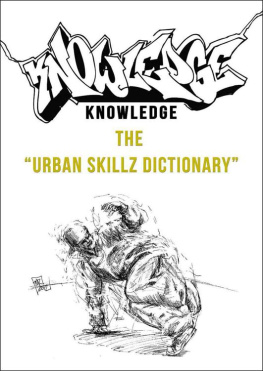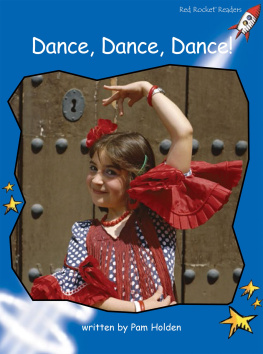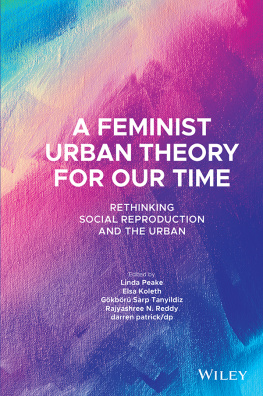WHEREVER A DANCER STANDS READY, THAT SPOT IS HOLY GROUND.
MARTHA GRAHAM

REMARK
All information in this book was diligently developed and compiled by the author. All the same, mistakes cannot be ruled out. For the notification of possible mistakes the author is thankful any time. Commercial use is only possible with the consent of the author.
No reproduction without permission.
All rights reserved!
The author does not assume liability for errors contained in damages arising from the use of the book.
2013 Sezai Coban
ISBN
978-3-944309-23-1
CONTENT
Sezai Coban
CONTENT-ASSISTENTS
Gianni Esposito & Mike Saretzki
COVER
Tanzer Caylak
PICTURES
Sezai Coban, Fabian Kimoto, Fikri Gren
Art & Design: Sezai Coban / Fabian Kimoto
Translation: Sezai Coban / Franz Kortmann / Nicholas Gordon
ARTWORK & LAYOUT
Freaky design & Art by ti-dablju-styles
Thomas Wiesen
www.ti-dablju-styles.de
freakystreetwear.spreadshirt.de
COVER ILLUSTRATION
Marc Robitzky
EBOOK PRODUCTION
mach-mir-ein-ebook.de
PERSON IN CHARGE
Sezai Coban
CONTACT
NOTE: PLEASE USE PUBLISHER FONTS ON YOUR DEVICE FOR BEST PRESENTATION OF THIS EBOOK.
CONTENTS
HISTORY OF UPROCKING
BACKGROUNDKNOWLEDGE
BACKGROUNDKNOWLEDGE
BACKGROUNDKNOWLEDGE
BACKGROUNDKNOWLEDGE
BACKGROUNDKNOWLEDGE
BACKGROUNDKNOWLEDGE
EXCERCISES


Heyyyyy! Lets kick a round of six-step then move over to this, combine it with that and then that style I always do! Then after well do this here and then everybody does this freeze. OK!
Listen bro, Ive seen so many other b-boys doing that exact same style!! Hows it gonna be if we kick the same thing? They gonna say were biters. Better if we do my style. Its totally easy. Wait a second, Ill show you!
Yeah, ok. Lets do that now and after well have to think about what we do next! It might be some time before we have another show!
This is how the conversation went at show training not long ago. Today it sounds more like this:
Now a round of six-step in bellyroll-up. Kick-out into extended pretzel then kick-out into chair! Top rock choreo well do a new one too!!
Got it?! So lets staaaaaart! In two days the show has to be perfect!
It was the above-mentioned situation made me think about making a collection of complete basics/foundations that I had learned and to make a collection of background knowledge connected with it. I realized that I could use the knowledge I had learned. That I could teach it to people and that they could pass it on to others.
In 1995, the beauty, complexity and creativity of b-boying, popping and locking put me under its spell! Even now, my fascination with this art continues. In the beginning we only knew a handful of basics such as the six-step and the kick-outs. The names of the powermoves were better known and easier to get to know: windmill, head-spin, flares and turtle. Thats why most of us were more occupied with powermoves in the beginning. We knew what they had to look like and what they were called! Footwork, popping and locking were simply more complex and not so easy for us to understand at the time. There were also a lot of moves that we just didnt do because we didnt want to be branded as imitators. So for years we basically ended up teaching ourselves. We trained according to our own ideas and basics, which were inspired by a diverse range of dancers, artists, combative athletes and others. We tried to create and adapt a flow of our own.
Over the years we learned more and more basics. We learned from experienced dancers who we met at jams, battles and other events, or from videos which had been copied about 50 times before we got hold of them. Still a lot of basics/moves remained out of our reach! We made slower progress than many dancers today because we had to travel a lot in order to make contacts and to collect information. We also accepted having to sleep at train stations because the last train went too early and the first train went too late!
Today its easier and most of this knowledge can be gained from the internet! The basics/foundations are not only a collection of movements, but also the means for passing on a part of a culture!
The Hip Hop culture!
Hmmmm But what is Hip Hop?
Some lyrics from the Krs-One & Marley Marl track Hip Hop Lives (I Come Back) come to mind. It goes like this:
Hip means to knowIts a form of intelligenceTo be hip is to be up-date and relevantHop is a form of movementYou cant just observe a hopYou got to hop up and do itHip and Hop is more than musicHip is the knowledgeHop is the movementHip and Hop is intelligent movement!
We only attain wisdom when we decide to listen and to learn and, for this reason, every voice should have the right to be heard!
In the song Peace, Unity, Love & Having Fun by Afrika Bambaata and James Brown they sing: What we need is KNOWLEDGE wisdom!
The human ability to learn and apply movements or things like languages and mathematics is nothing less than an outstanding intellectual achievement. Its independent of things like origin, educational, culture, social class or ethnicity.
Every human has a desire for artistic expression, whether through language, music, painting, clothing, dancing or other means. The number of possible movement sequences and the possibilities for expression connected with them are infinite. This is attributable to the infinite possibilities for combining individual movements.
Lets think of powermoves, of the infinite number of possible combinations with windmill/(continuous backspin), which can be attained by continuous combinations with other moves.
Windmill into TurtleWindmill into HeadspinWindmill Flare WindmillWindmill TrackWindmill into 9tEtc., etc., etc.
We dont all have to look the same when we dance. We arent machines; were humans with individual characteristics. When we dance we should have fun and enjoy it.
Its important to dance to the music and to recognize and utilize accents in the music to help us come out of our shells.
Weve seen a lot of dancers and a lot of very, very good dancers, who gave up dancing for various reasons such as social pressure or financial reasons. These dancers saw only limited or very few opportunities for them to support their existence.
In other countries such as France, the US and Denmark it isnt necessarily easier, but just different. You can find a greater degree of acceptance and tolerance. For instance, in the US its possible to climb up the professional ladder from a dishwasher to a millionaire; in Germany its more a question of where you got your certificate.
Not every dancer is cut out to be a dance teacher. You need much more than knowledge of the basics. A good dance teacher needs the right methods, techniques, approach and above all, a lot of patience and discipline. In recent years many things have changed and have been achieved! The scene has developed enormously. It has grown faster than anyone could have predicted and this has brought with it many new opportunities.
Dancers have succeeded in getting away from their practice rooms. Theyve been able to make a job out of their hobby and to earn a decent living from it. Dancers have found jobs in diverse stage shows, in theatres, as street artists, in Cirque de Soleil as dancing teachers, through culture and social work, as advertising representatives for diverse brands, as organizers of new dancing events and also through videogames. The list goes on and on. The times have certainly changed!
Next page















